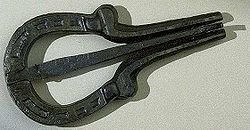Jew harp

Jew's harp found in the US (c. 1860s)
|
|
| Percussion instrument | |
|---|---|
| Other names | jaw harp, mouth harp, Ozark harp, juice harp, guimbarde |
| Classification | |
| Hornbostel–Sachs classification | 121.22 (Heteroglot guimbarde (the lamella is attached to the frame)) |
| Related instruments | |
The Jew's harp, also known as the jaw harp, mouth harp, Ozark harp or juice harp, is a lamellophone instrument, which is in the category of plucked idiophones: it consists of a flexible metal or bamboo tongue or reed attached to a frame. The tongue/reed is placed in the performer's mouth and plucked with the finger to produce a note. Each instrument produces one pitch only, with its multiples (overtones), though different sized instruments provide different pitches. There is no standard pitch.
Jew's harps may be categorized as idioglot or heteroglot (whether or not the frame and the tine are one piece), the shape of the frame (rod or plaque), by the number of tines, and whether the tines are plucked, joint-tapped, or string-pulled.
The frame is held firmly against the performer's parted teeth or lips (depending on the type), using the jaw and mouth as a resonator, greatly increasing the volume of the instrument. The teeth must be parted sufficiently for the reed to vibrate freely, and the fleshy parts of the mouth should not come into contact with the reed to prevent damping of the vibrations and possible pain. The note or tone thus produced is constant in pitch, though by changing the shape of his or her mouth, and the amount of air contained in it (and in some traditions closing the glottis), the performer can cause different overtones to sound and thus create melodies. The volume of the note (tone) can be varied by breathing in and out.
According to the Encyclopædia Britannica Eleventh Edition, "The vibrations of the steel tongue produce a compound sound composed of a fundamental and its harmonics. By using the cavity of the mouth as a resonator, each harmonic in succession can be isolated and reinforced, giving the instrument the compass shown."
...
Wikipedia
